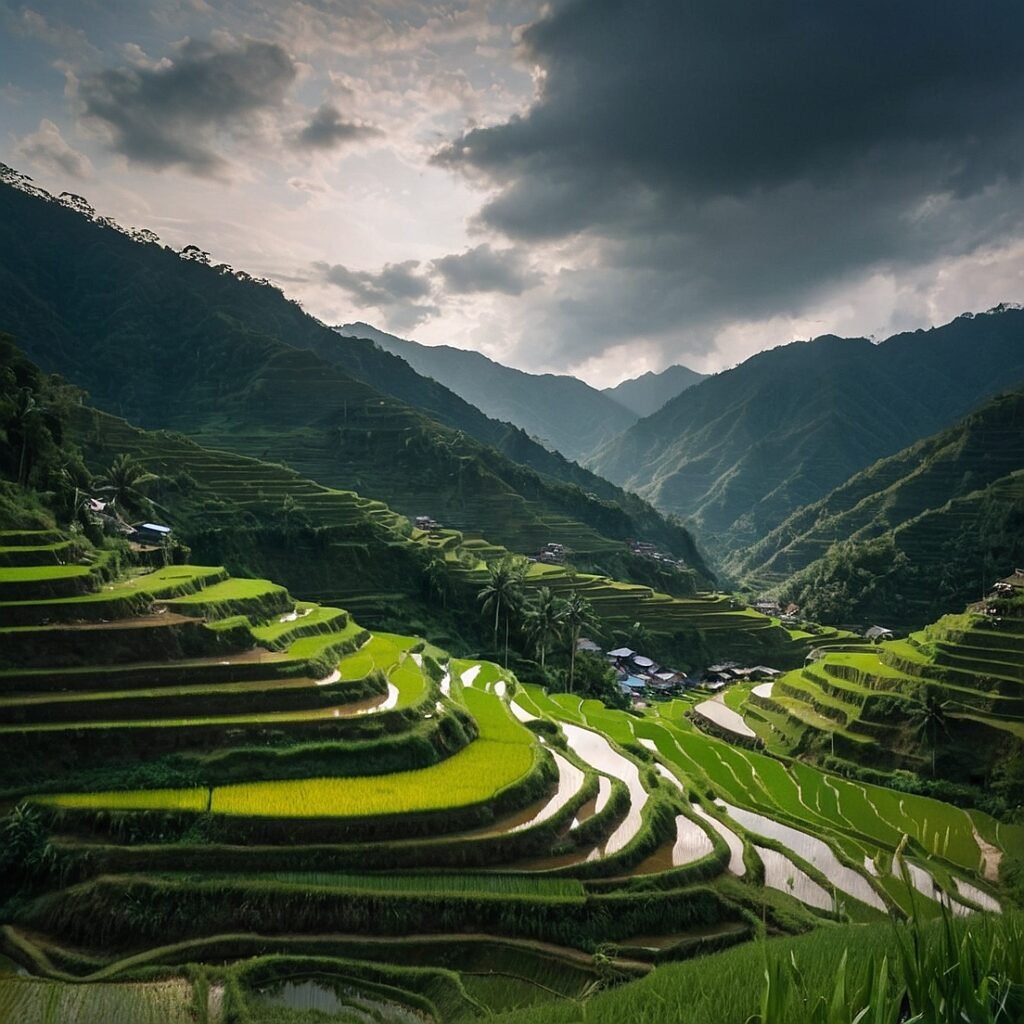The Banaue Rice Terraces, nestled in the Cordillera Mountains of northern Luzon, Philippines, stand as a testament to human ingenuity and perseverance. Often referred to as the “Eighth Wonder of the World,” these ancient terraces have been captivating visitors for centuries with their breathtaking beauty and engineering marvel. Carved into the mountainsides by the indigenous Ifugao people over 2,000 years ago, the Banaue Rice Terraces are not only a remarkable feat of agriculture but also a living cultural landscape that continues to thrive in the modern world. This extensive network of terraces, spanning approximately 4,000 square miles, showcases the harmony between human civilization and nature, demonstrating sustainable farming practices that have endured for millennia. In this comprehensive exploration, we will delve into the history, construction, cultural significance, and conservation efforts surrounding the Banaue Rice Terraces, shedding light on why this extraordinary site has earned its place on the UNESCO World Heritage List.
Historical Background
Origins and Early Development
The origins of the Banaue Rice Terraces can be traced back to the pre-colonial period of the Philippines, with some estimates dating their inception to as early as 1000 BCE. The Ifugao people, an indigenous group known for their advanced agricultural techniques, are credited with creating this intricate system of terraces. The construction of these terraces was not merely an agricultural endeavor but a response to the challenging terrain and climate of the Cordillera region. The steep mountain slopes and heavy rainfall necessitated an innovative approach to farming, leading to the development of the terraced fields that efficiently manage water resources and prevent soil erosion. Over centuries, the Ifugao people refined their techniques, passing down their knowledge from generation to generation, resulting in the expansive network of terraces we see today.
Cultural Evolution
The development of the Banaue Rice Terraces is intrinsically linked to the cultural evolution of the Ifugao people. As the terraces expanded and farming techniques improved, so did the social and religious practices of the community. The rice cultivation cycle became deeply intertwined with Ifugao rituals and beliefs, shaping their cosmology and social structure. The terraces were not just a means of survival but a reflection of the Ifugao’s worldview, where the harmony between humans and nature was paramount. This cultural significance has contributed to the preservation of the terraces over millennia, as each generation has taken on the responsibility of maintaining this ancestral heritage.
Architectural Marvel
Engineering and Construction
The construction of the Banaue Rice Terraces is a remarkable feat of ancient engineering. Built primarily using stone and mud walls, the terraces follow the natural contours of the mountains, creating a stunning landscape that appears to defy gravity. The engineering behind these terraces involves several key components:
- Retaining Walls: Sturdy stone walls, some reaching heights of up to 50 feet, are meticulously constructed to hold back the earth and create level planting areas.
- Irrigation System: An intricate network of canals and aqueducts distributes water from mountain springs and streams to each terrace level.
- Soil Management: Layers of clay and stone are carefully arranged to ensure proper drainage and prevent erosion.
- Terrace Design: The terraces are designed with a slight slope to allow excess water to flow to lower levels, preventing waterlogging.
The construction process was a community effort, requiring extensive knowledge of the local geography, hydrology, and soil conditions. This traditional knowledge, passed down through generations, allowed the Ifugao to create a sustainable agricultural system that has withstood the test of time.
Scale and Scope
The sheer scale of the Banaue Rice Terraces is awe-inspiring. Here are some key statistics:
| Feature | Measurement |
|---|---|
| Total Area | Approximately 4,000 square miles |
| Elevation Range | 2,000 to 6,000 feet above sea level |
| Terrace Height | Up to 50 feet |
| Estimated Length (if laid end-to-end) | 12,500 miles |
To put this into perspective, if the terraces were laid end-to-end, they would stretch halfway around the globe. This vast network of terraces is not confined to Banaue alone but extends into the neighboring municipalities of Mayoyao, Kiangan, and Hungduan, collectively known as the Rice Terraces of the Philippine Cordilleras.
Agricultural Significance
Rice Cultivation Techniques
The Banaue Rice Terraces are not just an architectural wonder but also a showcase of sustainable agriculture. The Ifugao people have developed sophisticated rice cultivation techniques that are perfectly adapted to the mountain environment. These techniques include:
- Water Management: The terraces utilize a gravity-fed irrigation system that efficiently distributes water from higher elevations to lower terraces.
- Seed Selection: Traditional rice varieties are carefully selected for their adaptability to high altitudes and resistance to local pests and diseases.
- Planting and Harvesting Cycles: The agricultural calendar is closely aligned with natural cycles, with planting typically occurring between February and March and harvesting in July or August.
- Pest Control: Natural pest control methods, such as the use of mud snails to control algae growth, are employed to maintain ecological balance.
These time-tested methods have allowed the Ifugao to produce rice in an environment where conventional farming would be impossible, demonstrating the potential of indigenous knowledge in sustainable agriculture.
Biodiversity and Ecosystem Services
The Banaue Rice Terraces are not just monoculture rice fields; they support a diverse ecosystem that provides numerous environmental benefits:
- Biodiversity Conservation: The terraces create various microhabitats that support a wide range of plant and animal species, including several endemic to the region.
- Soil Conservation: The terraced structure prevents soil erosion, preserving the fertility of the mountain slopes.
- Water Regulation: The terraces act as a natural water filtration and storage system, regulating water flow and reducing the risk of floods and landslides.
- Climate Regulation: The extensive vegetation cover of the terraces contributes to local climate regulation and carbon sequestration.
This multifunctional landscape demonstrates how traditional agricultural practices can contribute to biodiversity conservation and ecosystem services, offering valuable lessons for sustainable development in mountainous regions worldwide.
Cultural Significance
Ifugao Heritage and Traditions
The Banaue Rice Terraces are more than an agricultural system; they are the cornerstone of Ifugao culture and identity. The terraces are intricately woven into the fabric of Ifugao life, influencing their social structure, religious beliefs, and artistic expressions. Key aspects of this cultural significance include:
- Social Organization: The maintenance and operation of the terraces require a high degree of community cooperation, reinforcing social bonds and traditional governance structures.
- Religious Practices: The agricultural cycle is marked by various rituals and ceremonies, reflecting the spiritual connection between the Ifugao people and their land.
- Traditional Knowledge: The skills and knowledge required to build and maintain the terraces are passed down through generations, serving as a living repository of indigenous wisdom.
- Artistic Inspiration: The terraces have inspired various forms of Ifugao art, including wood carvings, textiles, and oral literature.
The cultural practices associated with the rice terraces have been recognized by UNESCO as Intangible Cultural Heritage, underscoring their importance in preserving Ifugao identity and traditions.
Impact on Philippine National Identity
The Banaue Rice Terraces have transcended their local significance to become a symbol of Philippine national identity. Their iconic status has made them:
- A source of national pride and a major tourist attraction
- A representation of Filipino ingenuity and resilience
- A focal point for discussions on indigenous rights and cultural preservation
- An emblem of sustainable development and harmonious coexistence with nature
The terraces’ prominence in national discourse has helped raise awareness about the importance of preserving indigenous cultures and traditional knowledge systems in the face of modernization.
Conservation Challenges and Efforts
Threats to Preservation
Despite their UNESCO World Heritage status, the Banaue Rice Terraces face numerous challenges that threaten their long-term survival. These include:
- Climate Change: Increasing frequency of extreme weather events, such as typhoons and droughts, poses risks to the terraces’ structural integrity and agricultural productivity.
- Rural-Urban Migration: Many young Ifugao are leaving their ancestral lands for urban areas, leading to a shortage of labor for terrace maintenance.
- Tourism Pressure: While tourism brings economic benefits, it also strains local resources and can lead to cultural commodification.
- Erosion and Neglect: Some terraces are suffering from erosion and neglect due to lack of maintenance.
- Pest Infestations: Introduction of non-native species and changing climate patterns have led to increased pest problems.
These challenges are interconnected and require a holistic approach to conservation that addresses both environmental and socio-economic factors.
Conservation Initiatives
Recognizing the importance of preserving this unique heritage site, various stakeholders have initiated conservation efforts:
- Government Programs: The Philippine government has implemented programs aimed at terrace restoration and support for traditional farming practices.
- UNESCO Support: As a World Heritage Site, the terraces receive technical and financial support from UNESCO for conservation projects.
- Community-Based Tourism: Initiatives to develop sustainable tourism models that benefit local communities while preserving cultural integrity.
- Educational Programs: Efforts to integrate traditional knowledge into local school curricula to ensure its transmission to younger generations.
- Research and Documentation: Ongoing scientific studies to better understand the terraces’ ecology and develop conservation strategies.
The table below summarizes some key conservation initiatives:
| Initiative | Description | Lead Organization |
|---|---|---|
| Terraces Restoration Project | Physical restoration of damaged terraces | Department of Agriculture |
| Ifugao Heritage School Program | Integration of traditional knowledge into school curriculum | Department of Education |
| Sustainable Tourism Plan | Development of eco-friendly tourism practices | Department of Tourism |
| Climate Change Adaptation Study | Research on climate resilience for terrace agriculture | Local Universities and NGOs |
| Community Seed Bank | Preservation of traditional rice varieties | Ifugao Farmers’ Association |
These multi-faceted efforts aim to address the complex challenges facing the Banaue Rice Terraces and ensure their preservation for future generations.
Tourism and Economic Impact
Visitor Experience
The Banaue Rice Terraces have become a major tourist destination, offering visitors a unique blend of natural beauty, cultural immersion, and historical significance. The visitor experience typically includes:
- Scenic viewpoints for panoramic views of the terraces
- Guided tours explaining the history and construction of the terraces
- Opportunities to interact with local Ifugao communities
- Trekking and hiking through the terraced landscapes
- Cultural demonstrations of traditional Ifugao crafts and practices
Tourism has brought both opportunities and challenges to the region. While it provides economic benefits, it also raises concerns about cultural authenticity and environmental impact.
Economic Contributions
Tourism to the Banaue Rice Terraces has become a significant contributor to the local and regional economy. The economic impact includes:
- Direct employment in the tourism sector (guides, accommodation, transportation)
- Increased demand for local products and handicrafts
- Investment in local infrastructure and services
- Diversification of income sources for Ifugao communities
However, ensuring that the economic benefits of tourism are equitably distributed and contribute to the preservation of the terraces remains a challenge.
Future Perspectives
Sustainable Development Goals
The conservation and management of the Banaue Rice Terraces align with several United Nations Sustainable Development Goals (SDGs):
- SDG 1: No Poverty
- SDG 2: Zero Hunger
- SDG 11: Sustainable Cities and Communities
- SDG 13: Climate Action
- SDG 15: Life on Land
The terraces serve as a model for sustainable mountain development, demonstrating how traditional practices can contribute to food security, biodiversity conservation, and cultural preservation.
Innovations in Conservation
As the Banaue Rice Terraces face new challenges, innovative approaches to conservation are being explored:
- Digital Documentation: Use of 3D mapping and drone technology for accurate documentation and monitoring of the terraces.
- Climate-Smart Agriculture: Integration of modern climate adaptation techniques with traditional farming practices.
- Community-Based Conservation: Empowering local communities to lead conservation efforts through capacity building and resource management.
- Eco-Tourism Certification: Development of certification programs to ensure sustainable tourism practices.
These innovations aim to bridge traditional knowledge with modern technology and management practices, ensuring the long-term sustainability of the Banaue Rice Terraces.
Conclusion
The Banaue Rice Terraces stand as a testament to human ingenuity, cultural resilience, and sustainable living. As a UNESCO World Heritage Site, they represent not just the heritage of the Ifugao people but a universal legacy of harmonious coexistence between humans and nature. The challenges facing the terraces are significant, but so too are the efforts to preserve them. The future of the Banaue Rice Terraces will depend on the successful integration of traditional wisdom with modern conservation techniques, sustainable tourism practices, and community-led initiatives. As we continue to grapple with global challenges such as climate change and cultural homogenization, the lessons offered by this ancient wonder become ever more relevant. The Banaue Rice Terraces remind us of the potential for sustainable development that respects both cultural diversity and ecological balance, offering valuable insights for creating a more sustainable and equitable world.
Disclaimer: This article is based on currently available information and research. While every effort has been made to ensure accuracy, new discoveries or changes in conservation status may occur. Readers are encouraged to consult current sources for the most up-to-date information. If you notice any inaccuracies, please report them so we can promptly make corrections.




